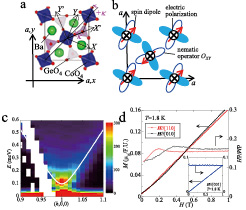Spin Nematic Interaction in Square-Lattice Antiferromagnet Ba2CoGe2O7
Masuda Group
The interaction between magnetic moments has been well known even before the establishment of quantum dynamics and the pioneering research on various types of the magnetic correlations by P. Curie is the basis of modern magnetism. Recently the correlation of the higher order of the spin operator has attracted theoretical interest in terms of hidden order in spin disordered state [1] but the direct experimental probe to identify the correlation is absent. Meanwhile in multiferroic compound that exhibits spontaneous order both in magnetism and dielectricity, the electric polarization is expressed by second order tenors of the spin operators [2], and the spin nematic operator comes to visible. In this fiscal year we demonstrate the existence of the spin nematic interaction in an easy-plane type antiferromagnet Ba2CoGe2O7 [3, 4] by exploring the magnetic anisotropy and spin dynamics. Combination of neutron scattering and magnetization measurements reveals that the dominant origin of the observed in-plane anisotropy is the ferro-type interaction of spin nematic operator instead of conventional single-ion anisotropy. The structure of the spontaneous polarization [10] is consistent with the ferro-type order of the nematic operators. The introduction of the spin nematic interaction is useful to understand the physics of spin and electric dipole in multiferroic compounds.

Fig. 1. a, Crystal structure of Ba2CoGe2O7. b, Structures of spin dipoles, spin nematic operator OXY , and electric polarizations in Ba2CoGe2O7. Red arrows are spin dipoles and open circles with crosses and small filled circles indicate the directions of electric polarization calculated by using the relation between spin nematic operator and electric polarization. Two-tone clovers are nematic operators. c, Inelastic neutron scattering spectrum. d, Bulk magnetization M and the derivative by field dM/dH in field along [110], [010], and [001] at T = 1.8 K.
The crystal structure of Ba2CoGe2O7 is schematized in Fig. 1a. The compound exhibits antiferromagnetic transition at TN=6.7 K and a staggered antiferromagnetic structure in the (001) plane was identified [3]. Below TN, a ferroelectric polarization is simultaneously induced [4]. Inelastic neutron scattering spectrum and magnetization measurements are shown in Figs. 1c and d, respectively. In the former clear anisotropy gap of about 0.12 meV is observed at the antiferromagnetic zone center Q = (100). In the derivative of magnetization curve, a peak due to spin flop is observed at the field H ~ 0.2 T in H // [110], the spin flop field increases in H // [100], and no spin flop is observed in H // [001]. The results mean that the magnetic easy axis is along the [110] direction. Meanwhile, the point symmetry of CoO4 tetrahedron, D2d, does not allow the magnetic anisotropy along 〈110〉 as far as single ion anisotropy and two-spin exchange anisotropy are considered. Thus the anisotropy is ascribed to the interaction of higher order of spin operator. Symmetry consideration leads to the relation between the electric polarization and the spin nematic operator, PX = −KabOYZ, PY = −KabOZX, and PZ = −KcOXY, , where X, Y, and Z are the local coordinates on CoO4 tetrahedron as shown in Fig. 1a. Among these OYZ and OZX are irrelevant to the anisotropy since the Z component of spin dipole is zero in the spin structure [3]. Hence we consider the nematic Hamiltonian Hp = -JpKc 2Σi,jOXY(i)OXY(j). Calculation of the classical energy including antiferromagnetic spin interaction and ferro-type nematic interaction between OXY operators leads the ground state to the staggered spin structure along 〈110〉 direction. The ferro-type nematic correlation depicted in Fig. 1b is consistent with the ferroelectric polarization along Z direction previously reported [4]. Both neutron spectrum and bulk magnetization are quantitatively explained by extended spin-wave calculation based on Hamiltonian including the ferro-type nematic interaction.
References
- [1] A. F. Andreev and I. A. Grishchuk, Sov. Phys. JETP 60, 267 (2984).
- [2] H. Katsura, N. Nagaosa, and A.V. Balatsky, Phys. Rev. Lett. 95, 057205 (2005).
- [3] A. Zheludev et al., B. Phys. Rev. B 68, 024428 (2003).
- [4] H. Murakawa et al., Y. Phys. Rev. Lett. 105, 137202 (2010).
